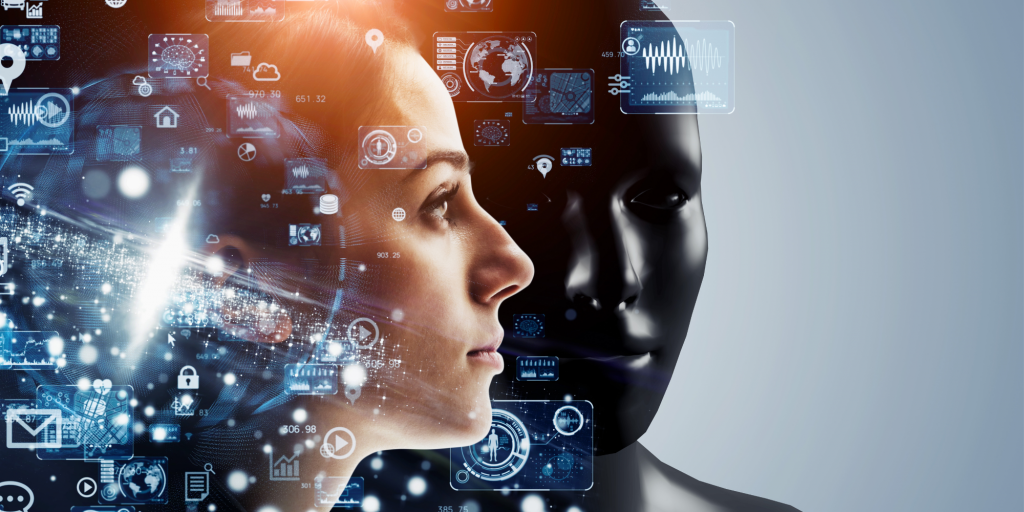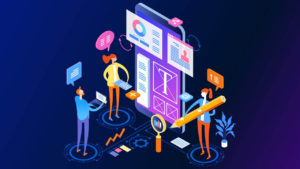
Artificial intelligence (AI) is transforming the healthcare industry in various ways, from improving diagnosis and treatment to enhancing patient experience and reducing costs. One of the most promising and innovative branches of AI is generative AI.
Generative AI uses deep learning models, such as generative adversarial networks (GANs) or large language models (LLMs), to learn from extensive data and produce realistic and diverse outputs.
According to a report by Market.us, the global Gen-AI in healthcare market size was valued at USD 1.2 billion in 2022 and is expected to reach USD 8.9 billion by 2032, growing at a CAGR of 22.7% during the forecast period.
Given the broad focus, this emerging technology has enormous potential to revolutionize healthcare in unprecedented ways, but it also poses some challenges and risks that need to be addressed.
What are the applications of generative AI in healthcare?
Generative AI has many potential applications in healthcare, such as:
• Data augmentation: Firms can create synthetic data that can augment the existing data and improve the performance and accuracy of other AI models. For example, creating synthetic medical images that can help train diagnostic or predictive models with more data and diversity.
American healthcare company, CloudMedX is a computing platform that improves patient outcomes using predictive analytics. It uses AI to collect data and build holistic pictures of individuals and communities. Its single, unified data platform has operational, clinical, and financial functions, meaning healthcare providers can find everything they need in one place.
The company’s predictive healthcare models can predict disease progression and determine the likelihoods that patients may have complications by processing medical data and providing risk assessment scores.
• Data privacy: Using generative AI, healthcare companies can create anonymized data to protect patients’ and providers’ privacy and security. For example, synthetic patient records can be used for research or analysis without revealing actual patients’ identities or sensitive information.
• Data generation: We can create new data or content that can provide insights or solutions for healthcare problems. For example, USA-based startup Persado uses generative AI to create personalized and persuasive content for healthcare communication and engagement. Their digital solutions, Persad PerScribed and Persado Motivation AI Platform have helped healthcare companies, insurers, and retail clinics conduct effective campaigns.
• Data enhancement: Generative AI can enhance the existing data or content by adding more details or quality. For example, the tech can help respond to patient queries better. Google DeepMind has developed MedPaLM, a large language model (LLM) trained on medical datasets that can respond to healthcare queries.
Nuance Communications, a technology provider of advanced conversational AI for ambient clinical documentation and decision support through voice biometrics; and specialized ambient sensing hardware, leverages Open AI’s Chat GPT to enhance customer responses and manage administrative tasks.
• Data synthesis: Generative AI can synthesize different data or content types to create a comprehensive and coherent output. AI-based firm Zebra Medical Vision has developed more than 11 algorithms to help medical professionals detect diseases better. Their HealthMammo tool is trained on over 350,000 mammogram reports and detects cancer with a 92% success rate compared to 87% among radiologists.
What are the challenges and risks of generative AI in healthcare?
Generative AI is still an evolving technology that faces some challenges and risks, such as:
• Quality and reliability: Generative AI may produce inaccurate or unrealistic outputs that may mislead or harm users. For example, it may generate false medical information that may affect diagnosis or treatment decisions or generate fake medical images that may violate ethical standards.
• Regulation and governance: There may be a lack of clear rules or guidelines for its development and use in healthcare. For example, there may be questions about accountability, transparency, explainability, fairness, and safety in healthcare settings.
• Ethics and trust: Given the lack of human touch, generative AI may pose ethical and social issues that may affect the trust and acceptance of users. The digital products using it creates may generate harmful or offensive content that affects public health in a worst-case scenario.
Conclusion
Generative AI is a rapidly evolving ecosystem of tools that holds enormous promise for healthcare. It can address some healthcare challenges, such as pandemics, chronic diseases, staff shortages, and administrative burdens. However, the technology also comes with its own challenges and risks that must be carefully considered and managed. Therefore, it is essential to develop trustworthy and responsible generative AI systems that can benefit healthcare without compromising its quality and integrity.
Knowledge thats worth delivered in your inbox
- SEO Powered Content & PR Distribution. Get Amplified Today.
- PlatoData.Network Vertical Generative Ai. Empower Yourself. Access Here.
- PlatoAiStream. Web3 Intelligence. Knowledge Amplified. Access Here.
- PlatoESG. Automotive / EVs, Carbon, CleanTech, Energy, Environment, Solar, Waste Management. Access Here.
- BlockOffsets. Modernizing Environmental Offset Ownership. Access Here.
- Source: https://www.mantralabsglobal.com/the-role-of-generative-ai-in-healthcare/
- :has
- :is
- 000
- 1
- 1.2 billion
- 11
- 2022
- 22
- 32
- 8
- 9
- a
- About
- acceptance
- accountability
- accuracy
- actual
- adding
- address
- administrative
- advanced
- adversarial
- affect
- AI
- AI in Healthcare
- algorithms
- also
- Ambient
- among
- an
- analysis
- analytics
- and
- applications
- ARE
- AS
- assessment
- At
- BE
- benefit
- Better
- Billion
- biometrics
- branches
- broad
- build
- but
- by
- cagr
- Campaigns
- CAN
- Cancer
- carefully
- challenges
- clear
- Clinical
- COHERENT
- collect
- comes
- Communication
- Communications
- Communities
- Companies
- company
- Company’s
- compared
- comprehensive
- compromising
- computing
- Conduct
- considered
- content
- Content Types
- conversational
- conversational AI
- Costs
- create
- creates
- Creating
- customer
- data
- Data Platform
- data privacy
- datasets
- decision
- decisions
- deep
- deep learning
- DeepMind
- delivered
- details
- develop
- developed
- Development
- different
- digital
- Disease
- diseases
- diverse
- Diversity
- documentation
- during
- ecosystem
- Effective
- emerging
- Emerging Technology
- engagement
- enhance
- enhancing
- enormous
- essential
- ethical
- ethics
- everything
- evolving
- example
- existing
- expected
- experience
- extensive
- faces
- fairness
- fake
- false
- financial
- Find
- Firm
- firms
- Focus
- For
- Forecast
- from
- functions
- generate
- generation
- generative
- Generative AI
- given
- Global
- governance
- Growing
- guidelines
- Hardware
- harm
- harmful
- harvard
- Have
- Health
- healthcare
- healthcare industry
- help
- helped
- holds
- holistic
- However
- HTTPS
- human
- identities
- images
- improve
- improving
- in
- inaccurate
- individuals
- industry
- information
- innovative
- insights
- integrity
- Intelligence
- issues
- IT
- ITS
- Lack
- language
- large
- LEARN
- learning
- leverages
- LLM
- manage
- managed
- many
- Market
- May..
- meaning
- medical
- medical data
- model
- models
- more
- most
- Motivation
- must
- Need
- networks
- New
- Nvidia
- of
- offensive
- on
- ONE
- open
- operational
- or
- Other
- outcomes
- output
- over
- own
- Pandemics
- patient
- patient experience
- patients
- performance
- period
- Personalized
- Pictures
- Place
- platform
- plato
- Plato Data Intelligence
- PlatoData
- poses
- potential
- predict
- Predictive Analytics
- Predictive healthcare
- privacy
- Privacy and Security
- problems
- processing
- produce
- Products
- professionals
- progression
- promise
- promising
- protect
- provide
- provider
- providers
- providing
- public
- public health
- quality
- queries
- Questions
- rapidly
- Rate
- reach
- realistic
- records
- reducing
- Regulation
- reliability
- report
- Reports
- research
- Respond
- responses
- responsible
- retail
- revealing
- revolutionize
- Risk
- risk assessment
- risks
- Role
- rules
- Safety
- scenario
- security
- sensitive
- settings
- shortages
- single
- Size
- Social
- social issues
- Solutions
- some
- specialized
- Staff
- standards
- startup
- Still
- success
- such
- support
- synthetic
- synthetic data
- Systems
- tasks
- tech
- Technology
- than
- that
- The
- their
- There.
- therefore
- they
- this
- Through
- to
- tool
- tools
- touch
- Train
- trained
- transforming
- Transparency
- treatment
- Trust
- trustworthy
- types
- unified
- unprecedented
- us
- USD
- use
- used
- users
- uses
- using
- valued
- various
- Voice
- Voice Biometrics
- was
- ways
- with
- without
- worth
- Your
- zephyrnet












